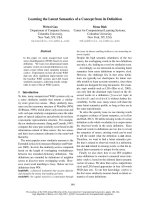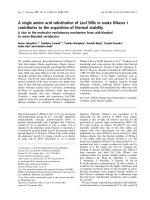Overview of Plant Biotechnology from Its Early Roots to the Present
Bạn đang xem bản rút gọn của tài liệu. Xem và tải ngay bản đầy đủ của tài liệu tại đây (376.7 KB, 11 trang )
Chapter 1
Overview of Plant Biotechnology from Its Early
Roots to the Present
Ara Kirakosyan, Peter B. Kaufman, and Leland J. Cseke
Abstract In this chapter, we first define what is meant by plant biotechnology.
We then trace the history from its earliest beginnings rooted in traditional plant
biotechnology, followed by classical plant biotechnology, and, currently, modern
plant biotechnology. Plant biotechnology is now center stage in the fields of alter-
native energy involving biogas production, bioremediation that cleans up polluted
land sites, integrative medicine that involves the use of natural products for treatment
of human diseases, sustainable agriculture that involves practices of organic farm-
ing, and genetic engineering of crop plants that are more productive and effective
in dealing with biotic and abiotic stresses. The primary toolbox of biotechnology
utilizes the latest methods of molecular biology, including genomics, proteomics,
metabolomics, and systems biology. It aims to develop economically feasible pro-
duction of specifically designed plants that are grown in a safe environment and
brought forth for agricultural, medical, and industrial applications.
1.1 What Is Plant Biotechnology All About?
Today, when science and technology are progressing at ever increasing speeds and
humankind is experiencing both positive and negative feedback from this progress,
the presentation of an overview of modern plant biotechnology concepts is highly
germane. Inherently, plant biotechnology, along with animal biotechnology, phar-
maceutical biotechnology, and nanotechnology, constitutes a part of what we term
biotechnology. An unprecedented series of successes in plant science, chemistry,
and molecular biology has occurred and shifted plant biotechnology to new direc-
tions. This means that the newer aspects of plant biotechnology seen today are
vastly different from our understanding of what constitutes the earlier, more tra-
ditional aspects of this field. The earlier ventures in biotechnology (traditional
biotechnology) were concerned with all types of cell cultures, as they were sources
of important products used by humans. These ventures included the making of beer
A. Kirakosyan (
B
)
University of Michigan, Ann Arbor, MI 48109-0646, USA
e-mail:
3
A. Kirakosyan, P.B. Kaufman, Recent Advances in Plant Biotechnology,
DOI 10.1007/978-1-4419-0194-1_1,
C
Springer Science+Business Media, LLC 2009
4 A. Kirakosyan et al.
and wine, the making of bread, cheese, yogurt, and other milk products, as well as
the production of antibiotics, pharmaceuticals, and vaccines.
What has radically changed since these earlier discoveries in plant biotechnol-
ogy? With the advent of recombinant DNA technology and new approaches that
utilize genomics, metabolomics, proteomics, and systems biology strategies (Cseke
et al., 2006), it may now be possible to re-examine plant cell cultures as a reasonable
candidate for commercial production of high-value plant metabolites. This is espe-
cially true if natural resources are limited, de novo chemical synthesis is too com-
plex or unfeasible, or agricultural production of the plant is not possible to carry out
year-round. Indeed, a study of the biochemistry of plant natural products has many
practical applications. Thus, specific processes have now been designed to meet the
requirements of plant cell cultures in bioreactors. In addition, plant cells constitute
an effective system for the biotransformation involving the addition of various sub-
strates to the culture media in order to induce the formation of new products. The
specific enzymes participating in such biotransformation processes can furthermore
be isolated and characterized from cells immobilized on various solid support matri-
ces, such as fiber-reinforced biocers (e.g., aqueous silica nanosols and commercial
alumina fibers) that are now used in bioreactors.
Modern plant biotechnology research uses a number of different approaches that
include high-throughput methodologies for functional analyses at the level of genes,
proteins, and metabolites. Other methods are designed for genome modification
through homologous and site-specific recombination. The potential for including
plant productivity or agricultural trials is directly dependent upon the use of the new
molecular markers or DNA construct technology. Therefore, plant biotechnology
now allows for the transfer of an incredible amount of useful genetic information
in a much more highly controlled and targeted manner. This is especially important
for the use of GM (genetically modified) organisms, in spite of risks and limita-
tions that have been voiced by individuals and organizations not in favor of this
technology. It is noteworthy that a number of transgenic plants are being developed
for long-term potential use in fundamental plant science studies (Sonnewald, 2003).
Some of these transgenic plants also have significant and beneficial characteristics
that allow for their safe use in industry and agriculture. Biotechnological approaches
can selectively increase the amounts of naturally produced pesticides and defense
compounds in crop plants and thus reduce the need for costly and highly toxic pes-
ticides. This applies also to nutritionally important constituents in crops. The new
techniques from the gene and metabolic engineering toolbox will bring forth many
viable strategies to produce phytochemicals of medicinal and industrial uses.
Plant biotechnology research is, by nature, multidisciplinary. Systematic botany
and organic chemistry, for example, aim to elucidate the systematic position and
the evolutionary differentiation of many plant families. For instance, accurate and
simple determination of chemotaxonomy can be attributed to the science of describ-
ing plants by their chemical nature. This interdisciplinary scientific field combines
molecular phylogenetic analysis with metabolic profiling. Furthermore, it helps to
investigate the molecular phylogeny and taxonomy of plants and to investigate the
structural diversity of unique secondary metabolites found only in endemic species.
1 Overview of Plant Biotechnology 5
Besides the evaluation of some compounds as chemotaxonomic markers, one can
also focus on the structural elucidation of these unique secondary metabolites,
applying modern techniques of analysis.
We then come to the conclusion as to what plant biotechnology is all about:
it aims to impart an understanding of plant metabolism and how plant metabo-
Plant Biotechnology
Applications
Flavors
and
fragrances
Insecticides
Oils
Agricultural
Plant defense
Reproduction
Food
quality
Industrial
Pharmaceuticals
Ornamental
plants
Natural dyes
Agronomic plants
Fig. 1.1 A schematic representation of plant biotechnology applications
6 A. Kirakosyan et al.
lite biosynthesis is regulated by particular enzymes, transcription factors, substrate
availability and end-products and to apply this understanding to the economically
feasible production of specifically designed plants that are grown in a safe envi-
ronment and brought forth for agricultural, medical, and industrial applications
(Fig. 1.1).
1.2 Tracing the Evolution of Classical Plant Biotechnology
Early in the twentieth century, plant cell culture was introduced (White, 1943, 1963).
It had applications in plant pathology (Braun, 1974), plant morphogenesis, plant
micropropagation, cytogenetics, and plant breeding. Then, protoplast culture was
discovered (Cocking, 1960). It had applications in studies on cell wall biosynthesis,
somatic cell hybridization, and genome manipulation (Power et al., 1970). Paral-
lel studies led to the discovery that the ratio of auxin and cytokinin type hormones
in tissue culture media largely determined whether one obtained shoots, roots, or
undifferentiated callus tissue using tobacco (Nicotiana tabacum) as the model sys-
tem (Miller and Skoog, 1953; Murashige and Skoog, 1962). These three discoveries
in the plant sciences became the cornerstones of classical plant biotechnology.
The earliest roots of classical plant biotechnology emanate from studies by
agronomists, horticulturists, plant breeders, plant physiologists, biochemists, ento-
mologists, plant pathologists, botanists, and pharmacists. Their primary aim has
been to solve practical problems associated with (1) the use of classical meth-
ods of plant breeding to develop new cultivars of plants that are resistant to plant
pathogens, insect pests, and environmental stresses due to cold, drought, or flood-
ing; (2) field-crop yield improvement, especially as related to the development of
green revolution crop plants and of faster growing, higher yielding forest trees; (3)
improvements in the postharvest storage and handling of crops; (4) the use of plant
hormones to improve rooting responses of cuttings, enhancement of seed germina-
tion, breaking seed dormancy, prolongation of seed viability, and improvements in
seed storage technology; (5) the employment of plant propagation (e.g., micropropa-
gation via cell and tissue culture, grafting of new cultivars of plants); and (6) the use
of plant natural products for human needs. These problems have been resolved suc-
cessfully, primarily due to achievements in plant biology and crop science research.
In connection with point (6) above, these earlier studies focused mainly on a descrip-
tion of the different kinds of natural products produced by plants. The pursuit of this
direction became more popular in the past decades because many of the chemically
synthesized constituents showed adverse effects on human health. Furthermore, for
some constituents, chemical synthesis is either impossible or a very complicated
and costly process.
Collectively, plants make a vast array of small-molecular-weight compounds.
Most of these natural products are generally not essential for the basic metabolic
processes of the plant but are often critical to the proper functioning of the plant in
relation to its environment. With at least 100,000 so far identified, the total number
of such compounds in the plant kingdom is estimated to be much higher. Plants are
1 Overview of Plant Biotechnology 7
capable of producing a variety of pharmaceuticals, adhesives, and compounds used
for cosmetics and food preparation. Scientists working in this field have already
discovered impressive amounts of potentially useful constituents with antibiotic,
anti-inflammatory, antiviral, anticancer, cardiovascular, and other activities.
Natural products are believed to play vital roles in the physiology and ecol-
ogy of plants that produce them, particularly as defense elements against pests
and pathogens, or as attractants for beneficial organisms such as insect pollinators
(Cseke et al., 2006). Most metabolites produced never leave the plant, but occa-
sionally plant compounds, some of which attract and some of which repel, are the
basis for a complex type of communication between plants and animals. Because
of their biological activities, some plant natural products have long been exploited
by human beings as pharmaceuticals, stimulants, and poisons. Therefore, there is an
immense interest in isolating, characterizing, and utilizing these metabolites. While
plant natural products hold a great deal of potential use for many human ailments,
they are often made in only trace amounts within the specific plant species that
produce them. Furthermore, the biosynthesis of the various metabolites proceeds
along metabolic pathways that are highly complicated and located in one or more
cell compartment(s) (e.g., cell walls, membrane systems, the cytosol, and various
cellular organelles) within tissues that are often specialized for particular tasks. The
specific enzymes that catalyze the respective steps in each metabolic pathway are
encoded in nuclear, chloroplast, or mitochondrial genomes by specific genes.
Plant scientists enthusiastically endorsed the idea that plant cell and protoplast
culture would eventually lead to the production of natural products using in vitro
plant cell suspension cultures in bioreactors, similar to those produced by microbial
and fungal cells cultivated in bioreactors. However, this expectation, in large part,
failed to materialize, even in spite of ingenious strategies that were developed (Zenk
et al., 1977). Only a few compounds were able to be successfully produced in plant
cell cultures scaled-up in bioreactors for industrial applications (Verpoorte et al.,
1994; Cseke et al., 2006). The main limitations were attributed to relatively slow
growth rates of plant cells in shaker or bioreactor cultures, low rates of synthesis of
desired products, and synthesis of compounds not present in intact plants. In fact,
it was discovered in the course of these studies that biosynthesis of many types of
plant metabolites occurs only in organized shoots or roots, but not in cell cultures
per se. Thus, in vitro shoot or root cultures became an alternative strategy for the
production of desired metabolites (Kirakosyan et al., 2004).
Many scientists have now combined extensive research experience using plant
cell cultures in order to develop the best strategies for biotechnological application.
This is enabling us to follow-up in greater detail points of interest, both theoretical
and practical. Consequently, the development of an information base on a cellular
and molecular level has been considered as a cornerstone of plant cell biotechnol-
ogy. Using established cell cultures, it is now possible to define the rate-limiting
step in biosynthesis by determining accumulation of presumed intermediates, char-
acterizing the limiting enzyme activity, and probably relating it to the corresponding
gene for eventual genetic manipulation. Generally, this approach works for known
pathways. Therefore, step-by-step identification of all enzymatic activities that are









